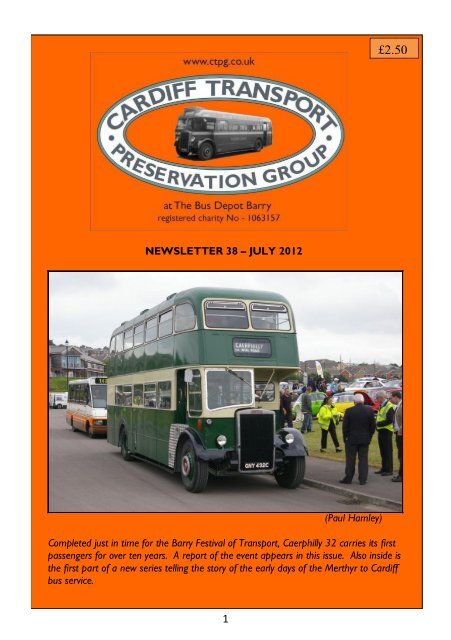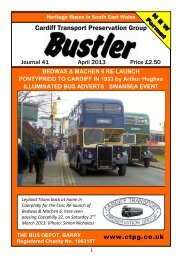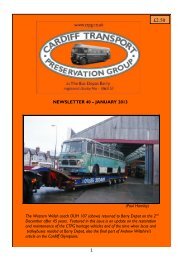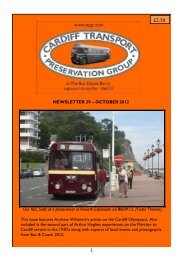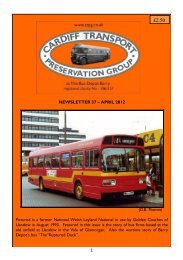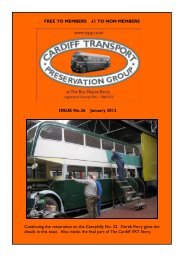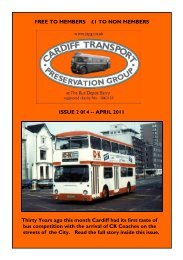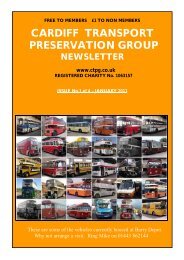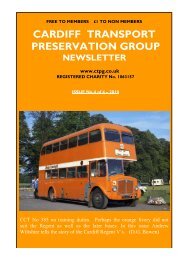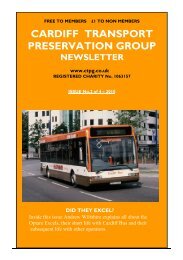Create successful ePaper yourself
Turn your PDF publications into a flip-book with our unique Google optimized e-Paper software.
£2.50<br />
00<br />
NEWSLETTER 38 <strong>–</strong> JULY <strong>2012</strong><br />
Completed just in time for the Barry Festival <strong>of</strong> Transport, Caerphilly 32 carries its first<br />
passengers for over ten years. A report <strong>of</strong> the event appears in this issue. Also inside is<br />
the first part <strong>of</strong> a new series telling the story <strong>of</strong> the early days <strong>of</strong> the Merthyr to Cardiff<br />
bus service.<br />
1 1<br />
1<br />
(Paul Hamley)
Barry Depot some 35 years ago under NBC control, with Leyland National KDW 335P.<br />
Below, in June <strong>2012</strong>, sporting the new “The Bus Depot” sign and NBC logo, under CTPG<br />
management with EDV 505D the MW coach owned by Richard Johnson. It looks much<br />
better doesn’t it!<br />
(CTPG / P. Hamley)<br />
2
CHAIRMAN’S MESSAGE;<br />
This year the Barry weather forecast certainly made for a lack <strong>of</strong> sleep right up to the<br />
Saturday afternoon before the Festival <strong>of</strong> Transport when the BBC decided that we<br />
would be dry. The majority <strong>of</strong> visiting buses arrived along with most <strong>of</strong> the entered cars.<br />
We had the crowds both public and enthusiast and luckily we made some money to put<br />
into our funds. Well done everyone who helped but we really need some additional<br />
volunteers. Included as part <strong>of</strong> the event was the launch <strong>of</strong> member Colin Scott’s long<br />
awaited Western Welsh story “Red, Cream and a touch <strong>of</strong> Gray.” Get your copies<br />
while you can, it comes well recommended.<br />
The weeks prior to the rally were very busy with MOT’s and general cleaning and<br />
tidying, again mainly the same people, plenty <strong>of</strong> servicing and checks were performed by<br />
our Depot team. In reality this means that we have a running fleet <strong>of</strong> eight buses,<br />
including newcomers Cardiff Ailsa 407 which seems quite unaffected by its time on Barry<br />
Dock and Caerphilly 32 which has been our main restoration project since its purchase<br />
on ebay 6 years ago. The amount <strong>of</strong> man hours alone would be huge besides the quantity<br />
<strong>of</strong> paint and new metal used. Many people have helped with this project but Alan and<br />
Derek have been there since the beginning. Our Swift is still toying with us, it was hoped<br />
to MOT it in time for Barry but we gave up on this after placing it onto the pits after<br />
which it stubbornly refused to start, maybe Merthyr! The National Welsh Olympian<br />
returned from the docks before the rally and received a coat <strong>of</strong> Poppy Red on the front<br />
which stands out in our line up.<br />
I hope we can take Caerphilly 32 out in July and Mike Walker should be supplying a<br />
vehicle for us to visit the Trolley Bus Group at Marshfield in August.<br />
We have a few more run outs to Ebbw Vale, Pontypridd and the Caerphilly Big Cheese<br />
before the Brislington Rally in August, let me know if you are interested in coming along.<br />
The Jones Cub visited Abertillery at the end <strong>of</strong> June for their classic vehicle show, this<br />
was the first time in a couple <strong>of</strong> years due to its engine rebuild, several old Jones’<br />
employees came to see us and the Cub performed well. We are hopeful that a couple<br />
more MOT’s may be completed prior to Merthyr, one <strong>of</strong> which will be another fresh<br />
rebuild. Come along and see!<br />
Those passing Barry Depot will have noticed the new signage on the depot (see photo<br />
opposite). We are very pleased with the results achieved by the Barry firm Spectrum<br />
Displays.<br />
I am looking to save 1958 Western Welsh AEC Reliance with Harrington bodywork<br />
OUH 107, if you can support us in saving this classic coach please let me know.<br />
We will also run buses and have an open day during the Tall Ships event in Barry the<br />
week before Merthyr.<br />
VOLUNTEERS URGENTLY NEEDED TO HELP AT MERTHYR RALLY<br />
Mike Tel: 07733 302242 Email : mikeystrad73@btinternet.com<br />
Also keep up to date on our Facebook page<br />
3
MEMORIES OF BUS COMMUTING IN THE 1930s by Arthur Hughes<br />
If Arthur Hughes is still alive today he would be a couple <strong>of</strong> years short <strong>of</strong> 100 years old. At the<br />
age <strong>of</strong> 18 in 1933 he began commuting by bus from his home in Merthyr Tydfil to Cardiff.<br />
In his retirement in Dublin he put his recollection <strong>of</strong> his younger days down on paper (we should<br />
all do that). He contacted our own Chris Taylor some 20 years ago for assistance with a view to<br />
publishing a book <strong>of</strong> his transport recollections. Chris was able to help him, but sadly publishers<br />
showed little interest at that time and then suddenly Chris lost contact with Mr Hughes. In<br />
editing the 140 page draft, Mr Hughes’s text has been left mainly as it was written. I hope<br />
readers enjoy these memories <strong>of</strong> the A470 corridor <strong>of</strong> 80 years ago. Ed.<br />
THE MERTHYR TO CARDIFF BUS; It was in October <strong>of</strong> 1933 that I began to<br />
commute between Merthyr and Cardiff, a process that would last for the next four and a<br />
half years. I lived in Merthyr, having been brought up there in the decaying years <strong>of</strong> its<br />
descent from being the greatest iron-making town to a sad scene <strong>of</strong> desolation and<br />
unemployment. Fortunately I was lucky enough to have found work in the City <strong>of</strong><br />
Cardiff, where the gloom and depression <strong>of</strong> those days were less <strong>of</strong> a prominence than<br />
in the mining valleys that lay behind it.<br />
Consequently, like many others, I elected to commute between the two places rather<br />
than face the dubious comforts <strong>of</strong> some stern-faced landlady’s accommodation. There<br />
was however, a further attraction which prompted me to opt for a shuttlecock<br />
existence, and it was this: you see in those far <strong>of</strong>f days anyway, I was undoubtedly a very<br />
rare breed - namely a bus enthusiast, something which was literally unheard <strong>of</strong> in those<br />
days. Things have changed a lot since then but I still get asked the stupid question now<br />
and then by some short-sighted person, “What do see interesting about a bus?”<br />
Merthyr was among the last town <strong>of</strong> any consequence in that part <strong>of</strong> the Principality to<br />
be connected to Cardiff by a through bus service. The probable reason for this was the<br />
stance <strong>of</strong> Merthyr Council towards the other bus operators. True enough, in the latter<br />
half <strong>of</strong> the 1920s it was possible to travel between Merthyr and Cardiff by bus, provided<br />
that the traveller had the strength and determination. To do so involved journeys on<br />
three local services, namely Merthyr Corporation’s service to Treharris, then Jones’s<br />
Commercial Motor Services, W.E. Evans <strong>of</strong> Treharris or Imperial Motor Services <strong>of</strong><br />
Abercynon to Pontypridd then with Rhondda, White’s Motors or Western Welsh to<br />
Cardiff. The Western Welsh licences were ex. Cridland and Tresillian Motors in<br />
November 1929. The entire journey took over two hours to complete in either<br />
direction compared to most train transit times <strong>of</strong> about 75 minutes.<br />
The end the 1920s was the time <strong>of</strong> the municipal bus expansion in South Wales, and<br />
came parallel with the rise <strong>of</strong> socialism. Councils were quite willing to grant each other<br />
licences whilst refusing them to companies or small operators using the lame excuse <strong>of</strong><br />
traffic congestion. The only way <strong>of</strong> getting justice was to appeal to the Ministry <strong>of</strong><br />
Transport, who would then set up an enquiry after which they would make a judgement.<br />
Even after this judgement, Merthyr Council would not permit Imperial Motor Services<br />
proper access until they were forced to carry out the Inspector’s ruling. Imperial applied<br />
for and against stiff opposition from Merthyr Council, obtained a licence to operate from<br />
4
Merthyr via Treharris and Nelson to Abercynon, connecting into and out <strong>of</strong> their<br />
Aberdare to Cardiff service at a bleak and inhospitable location just outside <strong>of</strong><br />
Abercynon and known, rather appropriately as the Traveller’s Rest (after a nearby and<br />
completely forlorn looking pub <strong>of</strong> that name). There was only one operated journey per<br />
day, namely the 7.35am from Merthyr with a return journey leaving Cardiff at 5.15pm.<br />
On 8th September 1930, came the introduction <strong>of</strong> an express service directly linking<br />
Merthyr and Cardiff, omitting the diversion via Nelson and without any change <strong>of</strong> bus on<br />
route. This was a joint venture between (after being forced upon them) Merthyr<br />
Corporation, Cardiff Corporation Tramways & Motors and Rhondda Tramways (which<br />
became Rhondda Transport in 1934). Imperial Motor Services also gained licences, but<br />
their service required a change <strong>of</strong> vehicle at Traveller’s Rest.<br />
Mr. Hughes Monthly ticket dated October 1933.<br />
THIS IS WHAT STARTED IT; It was in one <strong>of</strong> Rhondda buses I found myself<br />
sitting at 8.00am on that fateful morning in October 1933, all set to begin my<br />
introduction to daily travel on this route. An hourly service operated throughout the day<br />
leaving Merthyr on the hour and Cardiff at half past the hour. The only odd timings were<br />
the first bus out <strong>of</strong> Merthyr which rubbed the sleep out <strong>of</strong> its eyes at 7.10am and the last<br />
bus out <strong>of</strong> Cardiff which bade farewell to the city lights at 10.40pm instead <strong>of</strong> 10.30. The<br />
last bus from Merthyr was 11.00pm was in the hands <strong>of</strong> a Rhondda vehicle that went no<br />
further than Pontypridd, from whence it made its weary way up the Rhondda valley to<br />
the Porth depot. Similarly this bus entered service by leaving Porth at 6.55am and<br />
proceeded down to Pontypridd from where it operated in service up to Merthyr ready<br />
for the 8.00am departure to Cardiff.<br />
The <strong>of</strong>ficial running time was 80 minutes, but any driver who took much over 65 minutes<br />
was regarded with disfavour by all regular travellers, particularly in the evenings when<br />
the lights <strong>of</strong> home and all its comforts beckoned. The original frequency was found to be<br />
too frequent and was later reduced. (By <strong>2012</strong>, the Stagecoach X4 journey took just 55<br />
minutes.)<br />
5
A feature <strong>of</strong> the operations was the nightly exchange <strong>of</strong> vehicles between Merthyr and<br />
Cardiff Transport Departments on three nights a week. Every Monday, Wednesday and<br />
Friday the 10.00pm ex. Merthyr and the 10.40pm ex Cardiff ended their journey in<br />
foreign territory and spent the night among strange bedfellows. To accommodate this<br />
bus-like version <strong>of</strong> musical chairs, the crews exchanged vehicles at Nantgarw. The other<br />
days saw a return <strong>of</strong> these buses to their rightful garages to spend the night happily<br />
among friends. The Rhondda bus was not affected by this rigmarole.<br />
Sunday working ran from 1.00pm to 9.00pm from Merthyr and 1.30pm to 9.30pm from<br />
Cardiff. All three operators retrieved their own vehicles at the end <strong>of</strong> the day’s running.<br />
Christmas Day produced the spectacle <strong>of</strong> only the Merthyr bus venturing forth as per<br />
Sunday timetable, but the other two operators preferred that their crews sat around<br />
Christmas trees and pulled crackers, which left the service reduced to a three hourly<br />
headway and the passenger intake was virtually nil. To be fair the railway operated a<br />
Sunday service on this day. Neither Merthyr nor Rhondda systems used service<br />
numbers but Cardiff allocated the number 41 to be carried on their bus this being their<br />
highest route number at this time. As has already been mentioned this was <strong>of</strong>ficially<br />
referred to as an “Express” service, which in practice it more or less was, but no doubt<br />
due to some red tape, the licence as issued by the Traffic Commissioners left a small<br />
section in the middle <strong>of</strong> the route that was nothing more than a plain and simple stage<br />
carriage service.<br />
It came about this way. On the down journey, picking up was restricted to that section<br />
<strong>of</strong> route between Merthyr and the Cilfynydd tram terminus, about 13 miles away on the<br />
outskirts <strong>of</strong> Pontypridd, after which point setting down only was permitted for the<br />
remainder <strong>of</strong> the journey to Cardiff.<br />
The first setting down point after leaving Merthyr was the “New Concrete Bridge” at<br />
Quakers Yard some 9 miles down the valley. On the return run picking up was allowed<br />
all the way to Quakers yard, after which point it was setting down only, but no passenger<br />
was to be set down before reaching the Cylfynydd tram terminus. These zones were<br />
protection for the Merthyr local services, the Pontypridd trams (trolleybuses from Sept.<br />
1930) and the Pontypridd to Cardiff service. This then left a portion <strong>of</strong> the route some<br />
3 miles long that was free <strong>of</strong> all restrictions, but most passengers used the local services<br />
anyway. As might be expected with a joint operation <strong>of</strong> this nature, quite a variety <strong>of</strong><br />
buses materialised from time to time over the 4½ years which I spent on it.<br />
When the service first commenced in September 1930, Merthyr used a Leyland Lion<br />
PLSC or Bristol “B” until their 4 Lion LT2s were delivered in 1931. Merthyr had a<br />
choice <strong>of</strong> Bristol “B” but usually fielded their rear entrance version that at least had no<br />
front door to freeze our trotters <strong>of</strong>f and were quite comfortable with s<strong>of</strong>t sprung blue<br />
leather covered seats. Cardiff fielded a Dennis “E” in 1930, but due to poor<br />
performance it was soon replaced by a 6 cylinder Thornycr<strong>of</strong>t “BC” with 32 seat rear<br />
entrance body by NCME until the 5 new Leyland Tiger TS4’s were delivered in 1932.<br />
The “BC” was smooth running with 6 cylinder side vale petrol engine but point it at a hill<br />
and it would boil over, earning the nickname <strong>of</strong> “Teakettle”.<br />
6
A 1930 Advertisement showing a Merthyr Tydfil Corporation Bristol “B” Superbus with 32 seat<br />
BBW bodywork. New with petrol engines these four were numbered 22-25 in the fleet.<br />
7
The first Rhondda buses on the route varied between the 1928 Bristol “B” type or the<br />
1930 Albion PMA/PMB28 saloons. The Bristol “D” type was also used in 1931 but they<br />
all used too much petrol for what was, for Rhondda, not a very lucrative route. So when<br />
the five Lancets arrived the following year, one was assigned to this route. Very rarely<br />
would we see one <strong>of</strong> the Rhondda AEC Regals as, although they could tackle the hills<br />
well, it was the petrol consumption that kept them <strong>of</strong>f our route.<br />
When I commenced my journeying in October 1933 the regularly assigned vehicles were<br />
as follows. For Merthyr Corporation it was a Leyland Lion, while Cardiff put its faith in<br />
the Leyland Tiger and Rhondda trusted in the Dennis Lancet, and in almost every<br />
respect, each was as different as chalk is from cheese.<br />
HB 3278. Merthyr Corporation’s all Leyland Lion PLSC new in 1928.<br />
MERTHYR’S BUS; The Merthyr Lion LT2 was an all Leyland effort with very basic 32<br />
seat dual entrance bodies acquired in 1931. Originally they had petrol engines but in<br />
1934 they were given Gardner or Beardmore 6 cylinder oil substitutes, the latter giving<br />
much trouble later on. The unyielding seats were covered with a plain, drab light<br />
brownish red cloth which always looked if it could do with thorough cleaning. The<br />
provision <strong>of</strong> front and rear doors might have looked nice on a plan back up in Lancashire<br />
but all it ever succeeded in doing was firstly to reduce the available legroom to an<br />
uncomfortable degree and secondly introduce a forerunner to the present day air<br />
conditioning systems at a fraction <strong>of</strong> the cost. Once in motion an icy blast <strong>of</strong> air swept<br />
through the bus, entering through the badly fitting front door and exiting via the equally<br />
loose fitting rear door.<br />
In line with the popular choice <strong>of</strong> many municipal operators at that time, Merthyr’s livery<br />
was the inevitable maroon below the waist with cream above, including the ro<strong>of</strong>. In this<br />
instance the maroon was light and included more brown than red, while the cream area<br />
8
was more <strong>of</strong> a buttery yellow. Due to the poor state <strong>of</strong> the roads in Merthyr at that time<br />
the four Lions suffered cracked chassis that were replaced after a few years at the<br />
expense <strong>of</strong> Messrs Leyland.<br />
CARDIFF’S BUS; Cardiff Corporation, as already noted, relied on one <strong>of</strong> their<br />
Leyland TS4 with 32 seat rear entrance NCME bodies. These were 1932 vintage, <strong>of</strong><br />
which they had five. Thankfully with only rear doors the icy blasts never troubled us.<br />
These buses also came with petrol engines that were replaced by Leyland 6 cylinder oil<br />
engines after a couple <strong>of</strong> years. This was a heart-breaking change for me as prior to this<br />
they were an enthusiast’s dream in which to ride. The petrol engines oozed with silent<br />
power and gave out a magic whine that was music to the ears. In the hands <strong>of</strong> a capable<br />
driver they more than lived up to their reputation as the “Rolls Royce <strong>of</strong> Commercial<br />
Vehicles.” These buses have left me with pleasurable memories that will live as long as I<br />
do. After conversion they were fitted with governors which limited their top speed to<br />
slightly less than 32 mph bringing them into line with the Merthyr Lions.<br />
KG 1143. Cardiff No. 78, one <strong>of</strong> five NCME bodied Leyland Tiger TS4’s supplied in 1932.<br />
Internally the seating was <strong>of</strong> the half bucket type set at a slight backward rake, covered in<br />
a dark red leather cloth. This provided the most comfortable seating which hugged the<br />
body <strong>of</strong> the occupant. Legroom was also ample even for the long legged. Mottled<br />
leather cloth rose from the floor to window level matching the seating in colour and a<br />
touch <strong>of</strong> elegance was afforded by chrome plated grab handles, shaped like a large golf<br />
ball and attached to the rear <strong>of</strong> the seats lining the gangway. Another interesting feature<br />
<strong>of</strong> the buses was the revolving ro<strong>of</strong> ventilators which did a reasonable job <strong>of</strong> keeping the<br />
air at a breathable level, even when loaded with a couple <strong>of</strong> pipe smokers thrown in for<br />
good measure. The effect <strong>of</strong> these revolving ventilators was most unusual to see as they<br />
drove past.<br />
9
Cardiff’s livery also followed the maroon and cream tradition with the former up to the<br />
window level and the cream above it, however the shade <strong>of</strong> maroon was much deeper<br />
and richer than that <strong>of</strong> the Merthyr vehicle and the cream came in a lighter shade <strong>of</strong> the<br />
bovine product. The bodies were re-built before the war and again in the post-war era<br />
and most <strong>of</strong> the batch were still in service 20 year after they were built.<br />
RHONDDA’S BUS; The Rhondda Dennis Lancet was by contrast something <strong>of</strong> a<br />
mixed blessing. Acquired in 1932, it was a combination <strong>of</strong> a chassis with a 4 cylinder oil<br />
engine, <strong>of</strong> Lanova design, surmounted by a superb Weymann rear entrance 30 seat body<br />
which was a pleasure in which to travel. This comfort was marred by the weakness <strong>of</strong><br />
the engine, which especially on the up journey from Cardiff was no match for the spirited<br />
Tigers and Lions whose transit time was at least eight to ten minutes shorter that the<br />
Dennis could do.<br />
It was a wonderment to me that so many <strong>of</strong> these models turned up on the roads <strong>of</strong><br />
South Wales where hills abound and level roads are the exception. The reason<br />
obviously was that they were cheap to buy, costing only about 2/3 rd the price <strong>of</strong> a Regal<br />
or Tiger. Their saving grace however, was the fact that they were not fitted with a<br />
governor and that on the down journeys could be wound up to around 45 to 50 mph<br />
when the road was clear.<br />
TG 2788. A Weymann bodied Dennis Lancet new to Rhondda in 1932.<br />
Of all the coachbuilders in the 1930s the Weymann products stood out for their<br />
excellence in both construction and finish. They had s<strong>of</strong>t, well sprung and comfortable<br />
seats covered with cherry red leather cloth, a mottled variation <strong>of</strong> which lined the walls<br />
<strong>of</strong> the bus up to window level. A similar material shading from rose red at the sides to a<br />
light pink in the centre covered the ceiling while polished hardwood, mahogany in<br />
appearance, was applied around the windows and just about everywhere it was possible<br />
10
to incorporate it. It was a standard that Rhondda set during all the years I travelled on<br />
their buses. Rhondda’s livery was an overall maroon, relieved with a chocolate band<br />
with gold lining just below the window level. The mudguards were black and the fleetname<br />
was carried in gold letters not only on the side <strong>of</strong> the bus but also on the rear. In<br />
this case the maroon was more a true representation <strong>of</strong> this colour and was similar to<br />
that used by the LMS Railway Co.<br />
Jack-knife doors were fitted to all three types <strong>of</strong> bus and their operation was quite a<br />
chore for the conductor, though this varied from the Merthyr’s Leyland with its loose<br />
fitting doors which were almost as difficult to keep shut as they were to open, to the<br />
Rhondda’s tight fitting variety which kept out the dust, but require brute force to open<br />
and shut with liberal applications <strong>of</strong> oil from the dipstick when no-one was looking.<br />
So much for the buses I travelled on: Next time we shall look at the route and the other<br />
buses I found on my journeys. (Photos from the Chris Taylor Collection)<br />
--------------------------------<br />
BARRY DOUBLE DECK CENTENARY;<br />
In July 1912 this type <strong>of</strong> bus was the first double deck to run on the streets <strong>of</strong> Barry.<br />
Thomas White <strong>of</strong> the Barry Motor Bus Co. purchased three Saurer 24/28 hp chassis<br />
with 34 seat open top<br />
bodywork by Brown & Hughes<br />
from Hull Corporation.<br />
These buses were from a batch<br />
<strong>of</strong> 6 new in 1905 to the Mersey<br />
Railway Co.<br />
Mr. White tested these buses<br />
at Hull and bought them for<br />
£400 with spares and arranged<br />
for them to be transported to<br />
Barry by rail. It was said that<br />
two were kept in the Kendrick<br />
Road garage and one in the<br />
garden <strong>of</strong> his home at 105<br />
Broad Street, Barry. (opposite<br />
Barry Depot, next to the tyre<br />
sales (the words “Barry Garage” can still be seen on the wall in College Road).<br />
At least one bus was later converted into a charabanc and it was said that the two<br />
double decks were still in store at the Kendrick Road Garage in 1924.<br />
------------------------------------<br />
11
APRIL MEETING;<br />
The attendance was down a little for our meeting at Penarth Conservative Club on 18 th<br />
April. Our member Robert Edworthy travelled down from Rogiet, near the Severn<br />
Bridge, to give us an evening slide show (from a C.D. actually!).<br />
Firstly we saw a selection <strong>of</strong> 400 views <strong>of</strong> Western Welsh, Red & White and National<br />
Welsh buses and after the break there were views <strong>of</strong> the vehicles <strong>of</strong> South Wales<br />
Transport, United Welsh and Thomas Bros.<br />
Thanks, Robert for entertaining us once again.<br />
-----------------------------------------<br />
MAY ROAD RUN;<br />
Our first road run <strong>of</strong> the year followed the well-trodden route down the Vale towards<br />
Llantwit Major on one <strong>of</strong> the few sunny spring evening <strong>of</strong> this year. Our transport was<br />
the double deck known as “Ponty No.8” ably driven by Paul Burgess.<br />
Along the Cowbridge by-pass the bus pulled well up the hill but when Bonvilston was<br />
reached it seemed to automatically come to a halt outside the “Red Lion” which was<br />
fortuitous as most had by then worked up quite a thirst.<br />
Let’s hope we have a few more passengers on our subsequent road runs, after all it’s still<br />
a cheap evening out.<br />
-------------------------------------------<br />
FAREWELL TO CHELTENHAM;<br />
This event held on 27 th May is likely to be the last in a series <strong>of</strong> rallies celebrating the<br />
importance <strong>of</strong> the former Black & White Motorways coach interchange at St Margaret’s<br />
Road in Cheltenham. Cheltenham lost interchange status on 22 Jan 1984. On the 28<br />
April 1985 Black and White Motorways was absorbed by Cheltenham and Gloucester<br />
Bus Co. (later Stagecoach West). The site was closed late 1980's and the buildings were<br />
demolished in 1990, when the site became an open air car park. It is understood that<br />
redevelopment <strong>of</strong> the site is set to commence later this year, so sadly that may be the<br />
end <strong>of</strong> what’s left <strong>of</strong> the famous coach interchange site.<br />
Paul Hamley describes the day ---<br />
An early start was made from Barry Depot on Sun 27 th may at 8.0am with a small group<br />
<strong>of</strong> members, and Alan Jones in the cab in charge <strong>of</strong> the Beast (Tiger). HWO 323 has the<br />
benefit <strong>of</strong> wind-down windows which was a real bonus with the hot weather. There<br />
followed a nice gentle run up the M4/M5 with the Tiger "purring" along nicely, although<br />
we did get overtaken on the M5 by North Somerset Coaches newly purchased 1961<br />
Tiger Cub/ Alexander (ex Fife), which was already parked up when we arrived.<br />
We got to the rally site in central Cheltenham at1030 and the weather was sweltering,<br />
with a little patchy cloud arriving by about 3 p.m. There was a nice selection <strong>of</strong> mostly<br />
coaches (all regulars), and we were parked next to one <strong>of</strong> only 5 double deckers there,<br />
our coaches favourite friend, the ex R&W Guy Arab HWO342. The other 4 double<br />
decks were the FLF open top in BH&D livery, an ex-Oxford dual purpose VR mark 2<br />
looking immaculate, another VR a mark 3 ex Badgerline, and <strong>of</strong> course a ubiquitous RM.<br />
12
Richard Johnson arrived a little after us with the Royal Blue MW, and parked opposite.<br />
He had left on Saturday, and overnighted in Stroud. The group stall was then set up as it<br />
had been on his coach.<br />
There were regular trips from the site, mostly to the racecourse, and the open top FLF<br />
was in action all day full to the brim on every trip. We left in the Tiger just after the<br />
mass departure at 4 pm and after an uneventful journey arrived back at the depot about<br />
6.30. Coming back down the M5 we even managed to overtake one <strong>of</strong> the other<br />
vehicles from the rally, the Bristol groups’ ex-East Kent Regent V breakdown tender,<br />
although this did seem to be having a few problems.<br />
---------------------------------------<br />
BARRY AT WAR;<br />
13<br />
The CTPG played role in<br />
the Barry at War Weekend<br />
which was held a week after<br />
our Festival. Organised to<br />
recall the 70 th anniversary <strong>of</strong><br />
the U.S. Troops arriving the<br />
town, the event was well<br />
attended.<br />
In conjuction with the Barry<br />
Tourist Railway we provided<br />
an hourly bus service from<br />
the Hood Road site to the<br />
exhibition at Barry Island<br />
Priority movement! US troops make a dash while PAX Station calling at our depot<br />
loads up with passengers from the station. . which was open to visitors.<br />
A British Reconnaissance Officer on leave rides home on PAX.<br />
Note the wartime poster inside our bus. A nice touch! (photos Tudor Thomas)<br />
The vehicle used was PAX<br />
466F the ex. Bedwas &<br />
Machen Leyland PD3. This<br />
was fully loaded on the<br />
Sunday when the weather<br />
improved.<br />
Among the miltary vehicles<br />
at Hood Road were several<br />
Ford GPW & Willys MB<br />
Jeeps, GMC 6x6 trucks, a<br />
Diamond T 969 wrecker and<br />
surprisingly a life size replica<br />
Supermarine Spitfire.
<strong>2012</strong> BARRY FESTIVAL OF TRANSPORT;<br />
Sunday 10th June dawned with the weather looking indecisive (pretty much like our<br />
Swift). I arrived at the site at about 8.30, with a smattering <strong>of</strong> vehicles already there<br />
(mostly our own), but the classic cars soon started arriving in their droves, group by<br />
group or individually, and by 10 o' clock there were practically 150 on site all neatly<br />
parked up on the grass. The amount <strong>of</strong> MGs has to be seen to be believed. Some car<br />
owners decided to brave it out, and brought out the deck chairs and picnic hampers!<br />
This all kept the Barry Sea Cadets on the gate busy.<br />
The buses were also arriving with most <strong>of</strong> the regulars in attendance, and by 1030 there<br />
was a large queue waiting for the bus trips to start. First <strong>of</strong>f the blocks was the debut<br />
bus, Caerphilly 32 and this performed faultlessly for most <strong>of</strong> the day, creating much<br />
interest among the public. It also performed the last trip <strong>of</strong> the day to the Island (the<br />
first trip I managed to ride on all day). Cardiff Ailsa 407 was also performing public<br />
duties for the first time in over 4 years, and this was well patronised, especially when it<br />
did the Sully service in tandem with an immaculately restored sister Ailsa JOV 739P from<br />
WMPTE.<br />
The Barry Tourist railway also provided an intensive service using its class 101 unit.<br />
At about 11.00 we were visited by VIPs in the form <strong>of</strong> the Assembly Member for the<br />
Vale, Jane Hutt and Lis Burnett, the Vale Council Cabinet member for Regeneration,<br />
Innovation, Planning & Transportation who along with bus loving radio personality Roy<br />
Noble and our Chairman Mike Taylor, all rode on the AEC Renown "Megan" up to the<br />
depot.<br />
Once at the depot the stage was set for the launch <strong>of</strong> Colin Scott’s new book on the<br />
Western Welsh Omnibus Company named “Red, cream & a touch <strong>of</strong> Gray.” Roy Noble<br />
amused the crowd with his reminiscences <strong>of</strong> his youth journeying on the “Western<br />
Welsh.”<br />
There were several transport related sales stalls inside the depot and most seemed to<br />
do good business. Our refreshment room (aka Fitter’s Mess) was well frequented as<br />
was our museum room. The CTPG has received many more donations <strong>of</strong> bus artefacts<br />
and this year has installed four extra glass cabinets in the Brinkworth Room to display<br />
some <strong>of</strong> these items.<br />
Back at the Hood Road rally site the crowds settled down for the day, and the Hot Food<br />
stall had a long queue all day long. Unfortunately this year, there wasn’t an Ice Cream<br />
van on site as by mid-day it was very hot and muggy, with hazy sunshine (at least it<br />
wasn’t raining like last year).<br />
However, it was too good to last, and by about 3.0'clock it started to rain. Not too<br />
heavily, but enough to get people to pack up, and by 4 o'clock most <strong>of</strong> the cars had left<br />
and the buses from further away were also going. The free trips were still being well<br />
patronised (including the two open-toppers which got a little damp).<br />
All in all it was a great improvement on last year.<br />
(Paul Hamley)<br />
14
On its debut show with CTPG, the former Cardiff Bus Ailsa NDW 407X carries its first<br />
passengers for over four years, while below passengers alight from our Guy open-topper<br />
and others board former Pontypridd No.8 at the Hood Road rally site. (Paul Hamley)<br />
15
LEYLAND’S OLYMPIC HOPE;<br />
Over the next few weeks the <strong>2012</strong> London Olympic Games will<br />
be in full swing. Let me take you back to 1948, the last time that<br />
the Olympics Games were held in London.<br />
Leyland Motors planned to announce their new under floor<br />
engine bus at the London Commercial Motor Show that year,<br />
hence the model name ‘Olympic.’<br />
Due to production problems the announcement was delayed<br />
until the following year when four pre-production examples<br />
were assembled at the MCCW factory in Birmingham, though<br />
production models would be produced by Weymann at<br />
Addlestone. Designated HR40 for 40 passengers the Olympics<br />
were 27’ 6’’ long 7’ 6’’and featured integral construction with a<br />
horizontal version <strong>of</strong> the proven 0600 engine.<br />
Sales were not great. London Transport were loaned an early demonstrator for their<br />
Green Line services, but no orders followed.<br />
In South Wales, Red & White Services received the first two HR40 production models in<br />
May 1950 that remarkably had 3 fleet no’s in the first 18 months, (on paper anyway)<br />
79/80, S8-9/50, & U8-9/50. United Welsh took Olympic No.3, which 14 years later was<br />
transferred to the R&W fleet. James <strong>of</strong> Ammanford also bought an example. In later<br />
years, Llynfi Motors <strong>of</strong> Maesteg would become the home to two <strong>of</strong> the four<br />
demonstrators KOC 241-2.<br />
Within months <strong>of</strong> its first<br />
appearance the maximum<br />
permissible length for single<br />
decks was increased to 30 feet<br />
and subsequently a 44 seat<br />
version (HR44) appeared at<br />
the 1950 show. The Olympic<br />
was well-built with strong<br />
mechanicals but many UK<br />
operators <strong>of</strong> that time viewed<br />
integrals with distrust. The<br />
Olympic was quite heavy and<br />
R&W HWO 379 was the first production HR 40 model. showed little advantage as an<br />
integral. The same components<br />
were fitted to a separate chassis version with the same 15’ 7’’ wheelbase and announced<br />
in 1950 as the ‘Royal Tiger’. The Royal Tiger immediately became popular with UK<br />
operators. This trend continued in 1951, as Western Welsh took delivery <strong>of</strong> only ten 44<br />
seat Olympics but 25 Royal Tigers, all with Weymann bodywork.<br />
The first series Olympic gained only 90 sales in the UK, but subsequent models became<br />
more popular in overseas markets.<br />
16
17
BUS STAFF PHOTO;<br />
Can any reader please identify the occasion or the location? The bus in the background<br />
appears to be DWN 2, a Daimler COG5 that was new to Swan Motor Co., Swansea in<br />
1940. By 1947 it had been taken into the fleet <strong>of</strong> Red & White Services, then from 1951<br />
it spent 3 years with United Welsh Services.<br />
18
WWW? By Berwyn Prys Jones.<br />
It was supposed to be an ‘url’ weekend <strong>–</strong> a weekend <strong>of</strong> the three ‘w’s, Weston, Wells<br />
and Wythall <strong>–</strong>. but the heavy rain on the Easter Monday meant that it didn’t quite work<br />
out like that.<br />
Question: where, within 15 miles, <strong>of</strong> Cardiff can you now travel on a Lodekka in regular<br />
service? There’s a trick <strong>of</strong> course: it has to be 15 miles as the crow flies, across the<br />
Bristol Channel in Weston-super-Mare.<br />
And it was around the sixty or so miles <strong>of</strong> that estuary, spurred on by an advert for the<br />
Weston-super-Mare Transport Pageant in Bus and Coach Preservation magazine, that I<br />
went on Easter Saturday to get to Weston, a place I’d never visited in all the forty years<br />
I’ve lived in Cardiff.<br />
Having arrived at First-dominated Weston fairly early and noticing its preponderance <strong>of</strong><br />
S-registered double-deckers, I was on the point <strong>of</strong> finding a place to park when I looked<br />
in the mirror to see behind me the reverse ‘Crosville’ fleet-name adorning the front <strong>of</strong> a<br />
Dennis Dart in traditional livery. Thoughts <strong>of</strong> the recent Crosville-liveried Darts in<br />
Colwyn Bay and Aberystwyth crossed my mind but this was rather far from the those<br />
oh-so-civilised parts ...<br />
The Dart quickly turned <strong>of</strong>f and disappeared. I found a place to park and walked back to<br />
the promenade where the Transport Pageant was slowly getting its act together. One<br />
old car stood out for me <strong>–</strong> a Morris Imperial, one <strong>of</strong> only a few built and described on<br />
19
its ‘blurb’ as the product <strong>of</strong> a hopelessly uneconomic enterprise. The only bus <strong>of</strong> any<br />
variety was a Mercedes-Benz First-liveried minibus. So far, so disappointing!<br />
Things improved rather unexpectedly when one <strong>of</strong> the the Pageant’s stands turned to be<br />
that <strong>of</strong> Avon Owls. No, not a North Somerset imitation <strong>of</strong> all-night TfL services, but<br />
real owls from various parts <strong>of</strong> the world, rescued and looked after by a preservationist<br />
who sounded as enthusiastic and committed, in his own way, as a couple <strong>of</strong> well-known<br />
characters down at Barry depot.<br />
The owls ranged from a fair-sized beast to a tiny little one, though all shared that<br />
fearsome look <strong>of</strong> the born predator. For a pound you could get to hold one on your arm<br />
<strong>–</strong> on a leather ‘saddle’, <strong>of</strong> course <strong>–</strong> but I left that to a load <strong>of</strong> delighted kids.<br />
Still no buses, so a walk along the prom ensued to see the pier and the donkeys. I hadn’t<br />
seen the latter since a Sunday School trip by coach to Rhyl as a teenager nearly half a<br />
century before. Back at the Pageant, a few more interesting cars had arrived but nothing<br />
remotely omnibological.<br />
It was 11.30 and with no promising indications, I decided reluctantly to go home. Driving<br />
the car back down towards the Prom, though, another vision in Crosville-like cream and<br />
cream appeared, but this time on a Lodekka with ‘Southern Vectis’ on its side. I managed<br />
to catch up with it <strong>–</strong> no easy feat on a prom as busy as Weston’s. I also managed to pull<br />
in behind and was told by the driver that it would be leaving for Burnham-on-Sea in 20<br />
minutes. The ‘old bus’ ran, apparently, at 12 and 2. Ten minutes and a reserved parking<br />
space later, I was on the point <strong>of</strong> getting on the Lodekka (YDL 318) when I was asked by<br />
a welcoming couple whether I’d also be coming to Wells the following day!<br />
We left the prom at 12 and traversed an intricate route through Weston. It seemed to<br />
involve the twistiest and roughest piece <strong>of</strong> road in the whole town, making life more<br />
than a little difficult for the poor conductor, a youngish man who enjoyed some spirited<br />
and such-enjoyed repartee with his passengers.<br />
We eventually turned and twisted our way out <strong>of</strong> Weston with the Lodekka showing a<br />
nifty turn <strong>of</strong> speed. Past the Weston General Hospital and on to a short climb and we<br />
were away on the gentle downward-sloping A370 to Bridgwater as far as the turning to<br />
Burnham-on-Sea. There was the occasional sighting <strong>of</strong> further Crosville-liveried Darts<br />
combined with crossing the Great Western main line a couple <strong>of</strong> times. A glimpse <strong>of</strong> the<br />
M5 across a field or two made a pleasant sight and we were soon in Burnham. I’d hoped<br />
for a photo-stop there, but it was not to be. We dropped some passengers <strong>of</strong>f and<br />
started on our return journey.<br />
I’d expected us to go back the way we’d come but no, we went along the seafront past<br />
Pontin’s holiday camp and took the road to Lympsham. On flatlands, you expect the<br />
roads to be straight and trouble-free but, just like the road over the Wentloog levels,<br />
this one was twisty, occasionally narrow and fairly well-trafficked. I lost count <strong>of</strong> the<br />
number <strong>of</strong> ninety-degree bends. The poor driver’s elbows and knees must have come in<br />
for some pretty dire punishment. Then there was a rather narrow hump-backed at one<br />
point with, just beyond it, a handily-placed gate entrance just large enough to park a car<br />
in ... We eventually re-joined the A370 and returned to Weston promenade along a<br />
20
less punishing route than on the outward leg to end one hundred minutes <strong>of</strong> pretty<br />
continuous Lodekka travel.<br />
Though tempted to join the two o’clock service, I decided to ‘chase’ the Lodekka and<br />
film it climbing out <strong>of</strong> Weston and later on its return over said hump-backed bridge.<br />
The first sequence was a 180-degree shot that almost wound my legs into an inextricable<br />
tangle while the second, by the bridge, gave me a view <strong>of</strong> the Lodekka coming some<br />
distance away and enabled me to set up the camcorder and take a couple <strong>of</strong> still shots as<br />
well. Some shortcut chicanery meant that I was able to film another sequence as the<br />
Lodekka sped along the A370 back to Weston.<br />
Impressions? Compared to the Cumbrian Classic Coaches trip on their ex-Crosville<br />
Lodekka or ex-Bamber Bridge Titan, it doesn’t have the wild scenery <strong>of</strong> the pass from<br />
Brough to Middleton-in-Teesdale and the traffic in Weston tends to be heavy but if you,<br />
like me, are a Bristol fan, it’s well worth driving/swimming/paragliding over the Severn<br />
Sea (as we call it in Welsh) to sample its delights.<br />
The following morning saw me head for Wells, not the easiest place to get to from<br />
Cardiff, especially when there’s a three-way set <strong>of</strong> traffic lights <strong>–</strong> hence long queues <strong>–</strong> at<br />
Cheddar. The weather wasn't as good as on the previous day either, so I wasn’t too<br />
surprised to see that not too many enthusiasts had turned up at Wells to sample the<br />
running day. As I arrived, though, a fairly well-loaded LH departed the left half <strong>of</strong> the bus<br />
station that had been allocated to the rally for the day.<br />
21
There were eight or nine preserved buses there, all from the Bristol collections and<br />
ranging from a 1949 L to a couple <strong>of</strong> fairly ‘modern coaches’, a Leyland/Plaxton one and a<br />
Van Hool-bodied Volvo.<br />
A trip on the Bristol K (OHY 938) took us to the nearby village <strong>of</strong> Wookey where some<br />
difficulty was encountered in trying to get a rather large bus along the narrow road<br />
through a small village fairly well lined with cars. We eventually got to the car park <strong>of</strong><br />
Wookey Hole where we were able to turn and then return to Wells with far less<br />
difficulty. A ride to Glastonbury on Lodekka 969 EHW followed and then another ride<br />
on the K out to Green Ore. Sitting in the front seat downstairs, I watched the driver <strong>–</strong><br />
an old hand by all accounts <strong>–</strong> experiencing some difficulty in getting the K into gear at<br />
one point. Tricky things, these sixty year old buses! Fortunately, there was no traffic<br />
around and all was well until we returned along the narrow road in Wells where a male<br />
driver obstinately refused to follow the pattern set by other, mostly female, drivers and<br />
mount the pavement to let our K pass ...<br />
I’d hoped to get a ride on both the L (LHY 976) and NHU 2 (the prototype LS) but<br />
neither seemed to want to come out to play. Bristol LH DHW293K seemed keener to<br />
leave Wells and having seen that it had once belonged to Thomas <strong>of</strong> Llangadog (whose<br />
buses had, for a year, taken me to secondary school) I was suddenly keen to join it for a<br />
ride to Shepton Mallet via Dinder.<br />
What two girls in an otherwise deserted Shepton Mallet bus station made <strong>of</strong> the unlikely<br />
appearance <strong>of</strong> an LH with serious-looking gentlemen on board I’ll never know.<br />
Back to Wells again and time to leave. Luckily for me, the L had now sprung to life and<br />
left a side road ahead <strong>of</strong> me. It headed north-east on the A39 and soon started to climb<br />
a long, long hill. Its steady but slow climb led its very sensible driver to pull in here and<br />
there to allow cars to pass. I was very grateful as it meant that I could pass the L, stop at<br />
a couple <strong>of</strong> handily-placed locations and film it as it went by. There could hardly have<br />
been a better end, for me, to the inaugural Wells Running Day.<br />
The following day, being a bank holiday, it rained, so my third destination <strong>of</strong> Wythall had<br />
to be left till some later date in the year. Still, as the song says, ‘two out <strong>of</strong> three ain’t<br />
bad’.<br />
--------------------------------<br />
JUNE ROAD RUN:<br />
On the rainy evening <strong>of</strong> 20 th June our group travelled to Cardiff to follow the old 36<br />
service route from Cardiff to Caerphilly. Our steed was former Rhymney Valley 16, the<br />
1979 Leyland Leopard YBO 16T with an East Lancs B51F body. Withdrawn in 1989 it<br />
continued in service with several Midland operators and was expertly restored last year<br />
by our member Martyn Evans. He took a back seat to let Paul Burgess drive on this<br />
occasion. During the break at Caerphilly most <strong>of</strong> our group walked over to the new<br />
Wetherspoons that also has a tenuous transport link. The pub is named the “Malcolm<br />
Uphill” after a local motorcyclist who was the first to lap the TT course at over 100<br />
mph. On our return home we stopped briefly at the site <strong>of</strong> the old Caerphilly UDC<br />
depot in Mill Road which is now covered with private housing.<br />
22
The above was published in a 1960 Western Welsh Bulletin. What a relief that this<br />
scheme was amended before it came into force in the Cardiff area in February 1964 with<br />
ABO 1B (Cardiff) and ANY 1B (Glamorgan). It would have been even worse than the<br />
present silly system.<br />
-----------------------------------------<br />
LET’S PUT THE BOOT IN!<br />
23
DATES FOR YOU DIARY;<br />
Evening Meetings are held at 7.30pm at Penarth Conservative Club and<br />
Summer road runs will depart from Barry Depot at 7.00pm.<br />
Please check our website for updates. www.ctpg.co.uk<br />
Wed. 18 July<br />
Sat. 21 July<br />
Sun. 22 July<br />
Sat. 28 July<br />
Sat. 11 Aug.<br />
Sun. 12 Aug.<br />
Wed. 15 Aug.<br />
Sat/Sun. 1/2 Sept.<br />
Sun. 9 Sept.<br />
Wed. 19 Sept.<br />
Wed. 17 Oct.<br />
Sat/Sun. 20/21 Oct.<br />
Wed. 21 Nov.<br />
Wed 19 Dec.<br />
Evening Road Run from Barry Depot 7.00pm.<br />
Ebbw Vale Classic Bus Show & Family Fun Day.<br />
Celebrate15 years <strong>of</strong> “Bus & Coach Preservation” Magazine<br />
at Newbury Showground.<br />
Caerphilly “Big Cheese” Festival at the castle.<br />
Pontypridd Vintage Transport Day, Ynysangharad Park.<br />
Bristol Group & Avon Valley Running Day at Brislington.<br />
Road Run to C&SWTP Trolleybus Group at Marshfield<br />
Tall Ships Event at Barry Waterfront. Supported by CTPG<br />
Open day at the depot on both days.<br />
Bus & Coach Wales <strong>2012</strong>, again at Rhyd y car Leisure Centre,<br />
Merthyr Tydfil. URGENT; Volunteers required as Marshals.<br />
Talk by Stephen Wren <strong>of</strong> Stagecoach in South Wales arranged<br />
by the CTPG and the Omnibus Society.<br />
A Western Welsh Evening with author Colin Scott.<br />
Cardiff Model Railway Show at Glantaff School, Bridge Road,<br />
Llandaff. CTPG will provide a bus service on Saturday only.<br />
Slide Show TBA.<br />
Quiz Night hosted by Chris Taylor.<br />
EDITOR’S NOTES;<br />
The only member to email me the correct answer to the<br />
mystery bus in the last issue was John Shearman <strong>of</strong><br />
Tunbridge Wells. John identified it as a Fordson Thames 7V<br />
with Thurgood bodywork, registered early in 1949 by<br />
Oxford CBC. Well done John!<br />
Now try the one below! During World War 2 it ran in the<br />
Bristol area issued with the registration HHY 181.<br />
(G. Bruce Collection)<br />
24
25
About the CTPG<br />
The CTPG lease the former Western Welsh Depot on Broad Street, Barry from the Vale <strong>of</strong><br />
Glamorgan Council. The CTPG organises two vehicle rallies each year and holds a monthly meeting on<br />
the third Wednesday <strong>of</strong> each month at the Penarth Conservative Club. Members receive a quarterly<br />
newsletter and if they wish they can help to restore the Group’s buses, ride on them and travel to<br />
rallies.<br />
The Group aims to preserve representative samples <strong>of</strong> the buses that ran in South East Wales and the<br />
Valleys, as well as memorabilia and records <strong>of</strong> the operating companies.<br />
Annual membership <strong>of</strong> the Group is £20, which runs from the date <strong>of</strong> joining. Joint membership is also<br />
available for £25.<br />
CTPG Committee<br />
Chairman<br />
Mike Taylor, 10 Ger Nant Ystrad Mynach, Hengoed CF82 7FE<br />
Phone: 07733 302242<br />
email: mikeystrad73@btinternet.com<br />
Deputy Chairman Chris Taylor, 31 Heol Wen, Rhiwbina Cardiff CF14 6EG Phone:<br />
02920 693734<br />
Secretary<br />
Gayle Alder, 16 Carter Place, Fairwater, Cardiff CF5 3NP<br />
Treasurer Paul Hamley email: squash33@btinternet.com<br />
Membership Secretary<br />
Derek Perry, 11 Countess Place, Penarth CF64 3UJ<br />
Other Non Committee Post Holders<br />
Editor Viv Corbin email: viv.corbin@ntlworld.com<br />
Webmaster CTPG Mac Winfield email: postmaster@ctpg.co.uk<br />
Publicity Officer Tudor Thomas email: tudoralt@cf14.freeserve.co.uk<br />
www.ctpg.co.uk<br />
Published by the Cardiff Transport Preservation Group<br />
(Registered as a Charity No. 1063157)<br />
The opinions and views expressed in this publication are not necessarily those <strong>of</strong> the Group, its<br />
Committee or the Editor. Every effort is made to give due credit for all photographs and material used<br />
in this newsletter. Should there be any unintended breach <strong>of</strong> copyright; the Editor must be informed to<br />
enable a correcting acknowledgement to be made.<br />
26
A row <strong>of</strong> Bedford coaches at the <strong>2012</strong>Barry Festival. SB, WPT 738 and OB’s KEL94 & KYE<br />
905. Colin Scott & Roy Noble display the new book on Western Welsh, while Renown driver<br />
Tony Jenkins and his conductor John James look on.<br />
(V. Corbin / T. Thomas)<br />
27
28


